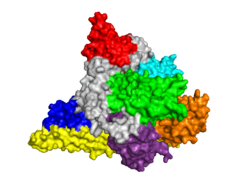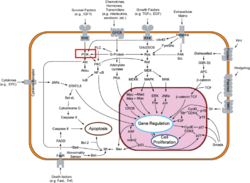User:Emma Charles/Sandbox 1
From Proteopedia
< User:Emma Charles(Difference between revisions)
(New page: ==Your Heading Here (maybe something like 'Structure')== <StructureSection load='1stp' size='340' side='right' caption='Caption for this structure' scene=''> This is a default text for you...) |
|||
| (3 intermediate revisions not shown.) | |||
| Line 4: | Line 4: | ||
You may include any references to papers as in: the use of JSmol in Proteopedia <ref>DOI 10.1002/ijch.201300024</ref> or to the article describing Jmol <ref>PMID:21638687</ref> to the rescue. | You may include any references to papers as in: the use of JSmol in Proteopedia <ref>DOI 10.1002/ijch.201300024</ref> or to the article describing Jmol <ref>PMID:21638687</ref> to the rescue. | ||
| - | == Human Tyrosinase related protein 1 | + | == General presentation of Human Tyrosinase related protein 1 == |
| - | '''Human Tyrosinase related protein 1''' ([https://en.wikipedia.org/wiki/TYRP1 TYRP1]) is a Cu2+/Zn2+ metalloenzyme found in [http://en.wikipedia.org/wiki/Human Humans]. It is expressed in [https://en.wikipedia.org/wiki/Melanocyte melanocytes] where it plays an important role in pigmentation. TYRP1 is also involved in [https://en.wikipedia.org/wiki/Melanoma melanoma] and [https://en.wikipedia.org/wiki/Albinism albinism]. Therefore, it represents an interesting target for therapy. | + | '''Human Tyrosinase related protein 1''' ([https://en.wikipedia.org/wiki/TYRP1 TYRP1]) is a Cu2+/Zn2+ metalloenzyme found in [http://en.wikipedia.org/wiki/Human Humans]. It is expressed in [https://en.wikipedia.org/wiki/Melanocyte melanocytes] where it plays an important role in pigmentation. TYRP1 is also involved in [https://en.wikipedia.org/wiki/Melanoma melanoma] and [https://en.wikipedia.org/wiki/Albinism albinism]. Therefore, it represents an interesting target for therapy <ref>PMID:21324755</ref>. TYRP1 can also be called : 5,6-dihydroxyindole-2-carboxylic acid oxidase (DHICA oxidase); Catalase B or Glycoprotein 75 (gp75). |
| - | TYRP1 can also be called : 5,6-dihydroxyindole-2-carboxylic acid oxidase (DHICA oxidase); Catalase B or Glycoprotein 75 (gp75). | + | |
== Synthesis and transport == | == Synthesis and transport == | ||
| - | Human Tyrosinase related protein 1 is encoded by the TYRP1 gene, which is located on the chromosome 9p23. The protein is expressed in [https://en.wikipedia.org/wiki/Melanosome melanosomes] and on the surface of melanocytes and melanoma cells. | + | Human Tyrosinase related protein 1 is encoded by the TYRP1 gene, which is located on the chromosome 9p23. The protein is expressed in [https://en.wikipedia.org/wiki/Melanosome melanosomes] and on the surface of melanocytes and melanoma cells <ref>PMID:21324755</ref>. TYRP1 protein is synthesized in the nucleus of melanosomes thanks to a signaling sequence. Then, it will be translated by the [https://en.wikipedia.org/wiki/Ribosome ribosomes]and the protein will be directly produced in the [https://en.wikipedia.org/wiki/Endoplasmic_reticulum endoplasmic reticulum]. Then it will be transported through the [https://en.wikipedia.org/wiki/Golgi_apparatus Golgi] to a specific organelles called melanosomes, where pigments are synthesized <ref>PMID:21324755</ref>. During its maturation, TYRP1 is glycosylated in asparagine in positions 96; 104; 181; 304; 350 and 395. The sorting in the trans-Golgi and transport of the TYRP1 protein to melanosome is dependant of several proteins such as the {{:Phosphoinositide_3-Kinases}} <ref>PMID:21324755</ref>, the [https://www.uniprot.org/uniprot/Q9UMX9 membrane associated transporter protein] (MATP) <ref>PMID:21324755</ref> and the [https://www.uniprot.org/uniprot/Q8TF64 GAIP interacting protein] (GIPC) <ref>PMID:11441007</ref>. The final TYRP1 protein is 537 amino-acids long. TYRP1 is transported to the membrane by the biogenesis of [https://en.wikipedia.org/wiki/Biogenesis_of_lysosome-related_organelles_complex_1 lysosome-related organelles complex 1] (BLOC-1) (wikipedia). The amino-terminal domain will be oriented in the lumen of the melanosome, and the carboxy terminal domain in the cytoplasm of the melanocyte <ref>PMID:11441007</ref>. TYRP1 is found only in the membrane of mature stage III and IV melanosomes <ref>PMID:21324755</ref>. |
== Function == | == Function == | ||
'''Role in melanocytes''' | '''Role in melanocytes''' | ||
| - | First, TYRP1 has a role in melanin biosynthesis. Indeed, this enzyme has a catalytic function in the melanin biosynthetic pathway. When a Cu2+ cation is bound, the protein catalyzes the oxidation of 5,6-dihydroxyindole-2-carboxylic acid (DHICA) into indole-5,6-quinone-2-carboxylic acid. This protein is also able to catalyze the oxidation of 5,6-dihydroxyindole (DHI) into indole-5,6-quinone. Both products will allow to obtain eu-melanin, while pheo-melanin is obtain thanks to [https://www.uniprot.org/uniprot/P40126 TYRP2] activity. | + | First, TYRP1 has a role in melanin biosynthesis. Indeed, this enzyme has a catalytic function in the melanin biosynthetic pathway. When a Cu2+ cation is bound, the protein catalyzes the oxidation of 5,6-dihydroxyindole-2-carboxylic acid (DHICA) into indole-5,6-quinone-2-carboxylic acid. This protein is also able to catalyze the oxidation of 5,6-dihydroxyindole (DHI) into indole-5,6-quinone. Both products will allow to obtain eu-melanin, while pheo-melanin is obtain thanks to [https://www.uniprot.org/uniprot/P40126 TYRP2] activity <ref>PMID:7813420</ref>. The activity of the TYRP1 enzyme increase when the serine residues in position 505 and 509 are phosphorylated <ref>PMID:11441007 </ref>. |
| - | However, the exact role of TYRP1 in pigmentation remains still unclear. Indeed, no gene polymorphism has been observed among caucasian population, despite the variation of hair and skin colors. | + | However, the exact role of TYRP1 in pigmentation remains still unclear. Indeed, no gene polymorphism has been observed among caucasian population, despite the variation of hair and skin colors <ref>DOI 10.1007/s003359900678</ref>. |
| - | In addition, the [https://www.uniprot.org/uniprot/P07147 mouse homolog of the TYRP1] is involved in melanocytes differenciation too. Therefore, it could be used as a differentiation marker. | + | In addition, the [https://www.uniprot.org/uniprot/P07147 mouse homolog of the TYRP1] is involved in melanocytes differenciation too. Therefore, it could be used as a differentiation marker <ref>PMID:2324688</ref>. In humans, the exact role of TYRP1 in differentiation of melanocyte is unclear. However, it is supposed that the protein is involved in the mechanism, as it is involved in pigmentation. |
'''Role in melanoma''' | '''Role in melanoma''' | ||
| - | TYRP1 also have a role in progression of melanoma. In fact, as TYRP1 is involved in the proliferation and differentiation of melanocytes, a mutation of the protein is associated with a higher risk for melanoma. | + | TYRP1 also have a role in progression of melanoma. In fact, as TYRP1 is involved in the proliferation and differentiation of melanocytes, a mutation of the protein is associated with a higher risk for melanoma <ref>PMID:21324755</ref>. Therefore, the level of expression of TYRP1 mRNA is prognostic marker <ref>PMID:22045183 </ref>. |
== References == | == References == | ||
Current revision
Your Heading Here (maybe something like 'Structure')
| |||||||||||



